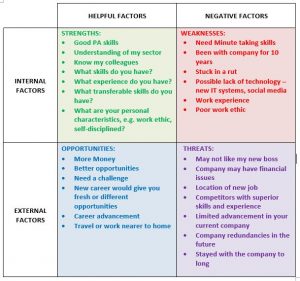Why would a PA need to know?

SWOT Analysis for PA Support decisions
Whether you are starting a business, expand an existing business or looking for a new PA Job, a SWOT analysis could help you to make the right choices for your business or career. SWOT is an acronym to remind you of subject headings you should think of when making those decisions.
What does SWOT Analysis mean?
The word SWOT breaks down like this:
S = Strengths
W = Weaknesses
O = Opportunities
T = Threats
S is for Strengths. In business, you could look at:
- What advantages does your company have over other companies doing the same thing? For example, the latest technology or more experienced staff.
- What do you do better than other companies?
- What is your Unique Selling Point (USP)?
- Do you have a loyal customer base?
When looking for a new PA Support role you could look at
- What skills do you have?
- Experience you have?
- Transferable skills do you have?
- What are your personal characteristics, e.g. work ethic, self-disciplined?
W is for Weaknesses. In business, you could look at:
- What can your company do better to improve revenue/performance?
- Is there anything your company should stop doing because it is not helping customer relations, or revenue or performance?
- Are your response times longer than they could be?
- Is there a problem with suppliers or distributers?
When looking for a new PA Support role you could look at
- Possible lack of technology – new IT systems, social media
- Work experience
- Poor work ethic
O is for Opportunities. In business, you could look at:
- Are there any gaps in the market that you could be moving into?
- Training opportunities for your staff that would give you an advantage over your competitors?
- Are there any Government Funding options that you can use?
- Is there a technological improvement that you could use?
When looking for a new PA Support role you could look at
- New career would give you fresh or different opportunities
- Career advancement
- Travel or work nearer to home
T is for Threats. In business, you could look at:
- What factors in the business sector in which your company works could cause your business to fail?
- Other companies in your business sector doing that could cause your business to fail?
- Is there a requirement for the business opportunity that you have identified?
- A change in legislation that will cause issues in the way that you currently do business?
- Has the customer base or customer requirement changed?
When looking for a new PA Support role you could look at
- Competitors with superior skills and experience
- Limited advancement in your current company
- Company redundancies in the future
- Stayed with the company too long
What does a SWOT Analysis template look like?
| HELPFUL FACTORS | NEGATIVE FACTORS | |
| INTERNAL FACTORS | STRENGTHS:
What does the business do well. e.g. Knowledge of market |
WEAKNESSES: What the business does not have e.g. Experience What it does not do as well as competitors e.g. warranty Out of date technology Out of date products Time it takes to deliver |
| EXTERNAL FACTORS | OPPORTUNITIES: There is any number of these. e.g. New customers New technology Government Grants New products New marketing strategies |
THREATS: Customers moving Interest in product declining New technology Government Grants ending New competitors Environmental factors e.g. weather |
How does a SWOT Analysis work?
A SWOT Analysis uses a template that allows you to look at the Strengths, Weaknesses, Opportunities & Threats in different ways. Firstly like this:
- Helpful things: The Strengths & Opportunities work together so that you identify opportunities based on your strengths.
- Harmful things: The Weaknesses & Threats work together so that you check can work on the weakness to ensure that the threats are not made worse.
Secondly like this:
- Internal Factors: Strengths & Weaknesses. These are internal to your company or They can be changed by you & your company.
- External Factors: Opportunities & Threats. These are things that are outside of your control & influence the way that your business can grow.
When should I use a SWOT Analysis?
A SWOT analysis can be used for all sizes of goals – from starting a company to expanding a company; researching a new product or service, or improving your career.
You can also use a SWOT Analysis for checking that the companies (suppliers & distributers, or subcontractors) that work with you are not increasing your threats or weaknesses, but are improving your strengths & opportunities.
Examples of a SWOT Analysis
- Should I start up my own business?
| HELPFUL FACTORS | NEGATIVE FACTORS | |
| INTERNAL FACTORS | STRENGTHS: Founder is qualified Start-up costs covered |
WEAKNESSES: Never run own business No staff to help |
| EXTERNAL FACTORS | OPPORTUNITIES: Gap in Market Interest in product |
THREATS: Other businesses doing similar work Supplier price may go up |
- Should I invest in new technology?
| HELPFUL FACTORS | NEGATIVE FACTORS | |
| INTERNAL FACTORS | STRENGTHS: Excellent reputation Good customer base |
WEAKNESSES: Declining market share Old technology |
| EXTERNAL FACTORS | OPPORTUNITIES: New technology will allow staff to complete work more quickly |
THREATS: Other businesses investing in new technology |
- Should I get a new PA job?

SWOT Analysis for PA Support decisions

